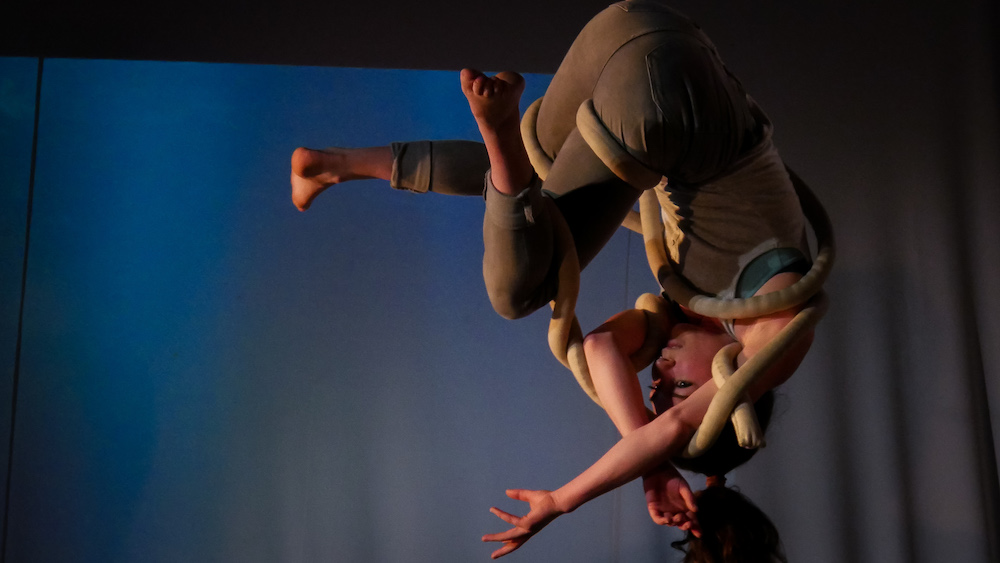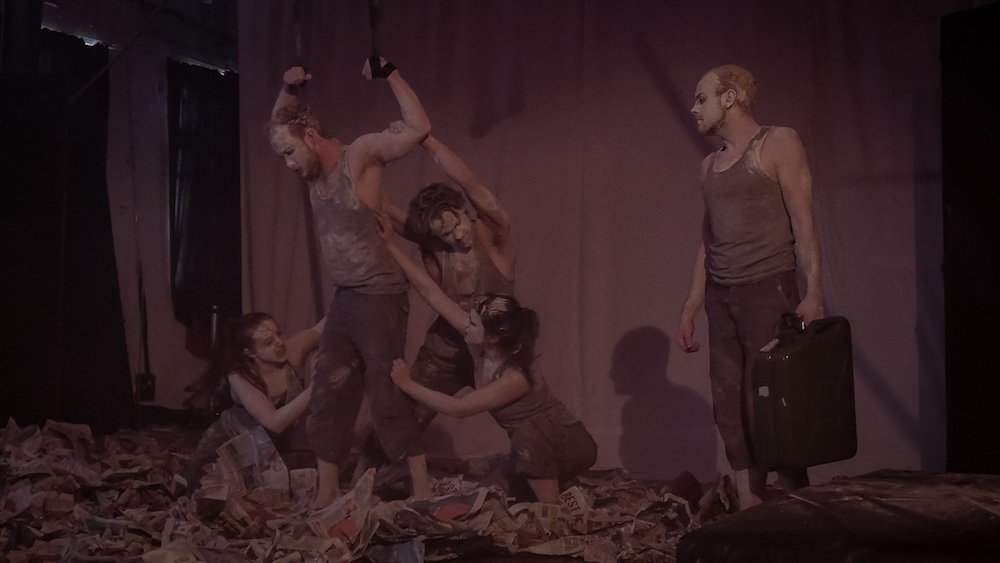Molding the Next Generation of Circus Directors at Circomedia

In Autumn 2019, Circomedia‘s Graduate Class of 2019 will be graduating with a masters degree in Directing Circus. The six MA students (Rachel Baird, Katja Kortström, Natalie Verhaegen, Jules Cooke, Kristian Kristof, and Janos Foldi) hail from the UK, Finland and Hungary, all with an eclectic background in circus as well as other art forms and interests.
Most things about this degree are new. According to Circomedia’s website, this is “the world’s only MA in Directing Circus,” they are only the second class to graduate this programme, and they’re all leaving with new works they have explored in school and will most likely continue to explore outside of it.
The foundations of this programme, one could argue, aren’t new at all. Led by Dr. Bim Mason, Artistic and Education Director, the programme takes place at Circomedia – the UK’s most veteran institution offering Circus Studies (founded in 1986 as “Fool Time” before being renamed “Circomedia” in 1994). For over 30 years the school has offered classes and degrees in various aspects of physical theatre and circus arts, and this new MA programme takes a school a step deeper into the academic world.
The course is split into five modules:
- Research Methodologies and Context: working alongside students from other performing arts disciplines to develop an understanding of, and ability to, research at postgraduate level, and learning about the historical, contemporary and geographical range of contexts for circus.
- Circus Directing 1, performer as source: A practical module that gives students the opportunity to explore a range of roles, responsibilities, and skills necessary to develop as a circus-based performance director, including dramaturgy, choreography, and design.
- Circus Directing 2, director as author: Developing directing skills with an in-depth project that shifts the emphasis from taught to independent learning. Working with undergraduate students to direct a circus-based act or performance piece.
- Professional Collaboration: This module encourages students to collaborate on a project with MA students in other performing arts fields or within a placement of a professional company.
- Final Project: MA students’ thesis content is decided in partnership with their course tutors. It can be a written piece, a practical work or a combination of both.
According to Circomedia, “The MA has been developed to address a recognised need across the global circus community to create and support a new kind of performance director – one who is aware of the possibilities and limitations of using circus techniques in an artistic context.”
This need to “create a new kind of performance director” they speak of resonated with me (a student at Circomedia’s full-time vocational course) a few months ago. When working on an excerpt from my show The Escape Act – A Holocaust Memoir for a class presentation, I felt I was too deep in my own creation loop to be able to assess what the piece needs. I asked Rachel Baird and Katja Kortström to provide their input. The process was very helpful: as a narrative piece where trapeze choreography had to interact with the character’s story arc, having an outside eye to advise and fine tune made all the difference. A theater director would not have had the physical knowledge deriving from circus that’s needed to help, and a circus artist would have lacked the dramaturgical point-of-view. Indeed, having a director who can bridge both worlds was essential.
I sat with four of the current MA students to talk about their experiences in the programme:
Stav Meishar: What made you choose this degree program?
Jules Cooke: A few things really – my interest in directing and creating shows specific to circus, the fact that it is the only one of its kind, the teachers running the program (Bim and JP) and the guest tutors associated (Sean Gandini,Charlotte Mooney andTina Koch of Ockham’s Razor, No Fit State, etc.) and finally – sheer curiosity.
Natalie Verhaegen: As I never wanted to be in the pieces themselves I could use the knowledge that I had gained as a performer yet be external to the work itself. There is very little support out there in the professional world for emerging directors that want to work with circus artists, this course has been perfect in helping me achieve my aims.
 Janos Foldi: I have taken a few years break from full time performing and anything creative really, mostly because I have been very disappointed in how art and especially circus arts have not been evolving the same way as other professions and just generally the world. We are in a situation where climate change, environmental disasters, different negative human behavior is booming, and instead of finding inspiration and solution through arts and to create meaningful art, we are still trying to be pretty princesses and thrive for stereotypes and feed into this new culture of stupidity. But then at the same time I love art, and with this course I have seen an opportunity to network and meet students, performers and other professionals through Bath Spa University and Circomedia, in the hopes to create a company what will specialise in these problems.
Janos Foldi: I have taken a few years break from full time performing and anything creative really, mostly because I have been very disappointed in how art and especially circus arts have not been evolving the same way as other professions and just generally the world. We are in a situation where climate change, environmental disasters, different negative human behavior is booming, and instead of finding inspiration and solution through arts and to create meaningful art, we are still trying to be pretty princesses and thrive for stereotypes and feed into this new culture of stupidity. But then at the same time I love art, and with this course I have seen an opportunity to network and meet students, performers and other professionals through Bath Spa University and Circomedia, in the hopes to create a company what will specialise in these problems.
Stav: What useful tools do you feel you have gained over the past months?
 Natalie: The best part of this course is having artists to work with. In the professional world it is extremely difficult to find artists who wish to work for free to fulfill a vision or to find funding and opportunities without first having created the work. Working with the undergraduate students here has been amazing, they have been incredibly talented and dedicated.
Natalie: The best part of this course is having artists to work with. In the professional world it is extremely difficult to find artists who wish to work for free to fulfill a vision or to find funding and opportunities without first having created the work. Working with the undergraduate students here has been amazing, they have been incredibly talented and dedicated.
Jules: Personally, I have found countless useful tools over the last few months that serve various purposes, covering everything from management and scheduling, making and creating, cleaning and refining, social media and marketing, working with performers, technical teams, etc., language and communication skills – verbal, non-verbal, written…. I guess if you want more specific answers you should probably take the course!
Janos: I have gained loads of confidence and motivation to research and learn about the craftsmanship of directing.
Stav: What were your most memorable moments?
Janos: One of them was when my performers told me they trust me because everything we have done had a meaning and it works, and it was artistically satisfying them at the same time.
Another one what will forever remember was the Christmas show, where five MA students directed one show. That was eye opening.
Katja: In collaborative projects you learn to delegate and communicate with other MAs. I enjoyed the Christmas show project with 1st year Circomedia students. Also the director-as-author project with 2nd year students was lovely and I learned so much by using live music.
Stav: You recently shared your director-as-author projects with the school. What were your projects about, and what was your experience working on them with 2nd-year FDA students as your performers?
Natalie: Mine was an ensemble production of the Inuit tale Skeleton Women integrating aerial, acrobatics and spoken word. Starting with death, it was a celebration of the challenges we must face to fully be alive. A simple narrative story that can be interpreted on the literal, personal and social level, making it interesting for adults and children alike.
With the processes that the MA had put in place, such as directorial visits from established companies, tutorials and work-in-progress showings, it meant that the piece of work shown was more developed than I had previously imagined. I am incredibly proud of it and can not wait to show it at Tilted, Jackson’s Lane Theatre, London on the 10th July.
Katja: This independent project gave a realistic picture of what can be expected on a professional field since the responsibility from the idea of a theme and style to final polished performance was on you. Contribution of self-casted artists for the ideas, circus tricks and live music added motivation both ways. Five weeks rehearsal period gave plenty of time for self-reflection which was an important part of the development.
The project was shown at Circomedia, when the audience was invited to witness the journey of a carer whose loved one had a fatal disorder. The feedback of the audience and performers added the useful knowledge for the future directing. The feedback from the professional circus artists in the audience indicates the success of the dramaturgy, use of live-music and cohesiveness of C.I.P.A. (Congenital Insensitivity to Pain with Anhidrosis). Besides, the visual consistency, thought-provokingness and the intense emotive tension was mentioned as the most impactful characteristics of the piece.
Now a month later, looking at the video of CIPA makes me satisfied. Goals were fulfilled: CIPA became an emotional piece with intense tension, the creation process was time efficient and the well-being of artists was not compromised.

The MA students are currently working on their final projects. For most of them, it will be a further development of their director-as-author projects. Some of them are also busy taking their projects to public performances over the summer, like Janos at Greenman Festival and Natalie at Peace in the Park Sheffield. I am excited to see where their career paths lead them over the next few months, as they graduate the MA course and take their newly-found skills to the next stage of their lives.
All photos courtesy of Harley Strong Performance and Media
Editor's Note: At StageLync, an international platform for the performing arts, we celebrate the diversity of our writers' backgrounds. We recognize and support their choice to use either American or British English in their articles, respecting their individual preferences and origins. This policy allows us to embrace a wide range of linguistic expressions, enriching our content and reflecting the global nature of our community.
🎧 Join us on the StageLync Podcast for inspiring stories from the world of performing arts! Tune in to hear from the creative minds who bring magic to life, both onstage and behind the scenes. 🎙️ 👉 Listen now!

